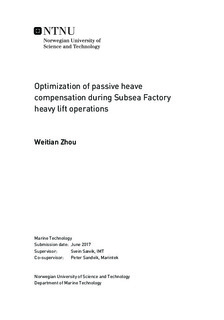Optimization of passive heave compensation during Subsea Factory heavy lift operations
Master thesis
Permanent lenke
http://hdl.handle.net/11250/2455241Utgivelsesdato
2017Metadata
Vis full innførselSamlinger
- Institutt for marin teknikk [3421]
Sammendrag
This thesis is about the study of the effect of heave passive compensation during subsea factory heavy lift operations. All the analysis are based on the data provided by Peter Sandvik, Marintek. The main objective is to demonstrate the positive effect of passive heave compensation and de- termine the optimized stroke of passive heave compensator by the static and dynamic analysis in SIMA program.The literature study is based on articles related to heave compensation during marine operation and DNV-RP-H103, which provides guidance for modelling and analysis of marine operations. The different types of heave compensator with different applications are introduced in the the- sis.Then, an introduction of SIMA program will be presented in chapter 4. Meanwhile how the models of environment conditions, different bodies and coupling specifications, as well as the calculation parameters are established in SIMA is illustrated in chapter 5.Moreover, five cases are performed in this thesis to prove that the passive heave compensator will contribute to the reduction of dynamic loads and motions during heavy lift operation. The analysis is performed in SIMA, a workbench used to solve tasks during marine operations. The lifting module is modelled as a combination of four same mudmat and the passive heave com- pensator is modelled by a fixed elongation coupling between the hook and cranemaster. As for the model without passive heave compensator, it just replaces the fixed elongation coupling be- tween the hook and cranemaster with a simple coupling wire.And all he results from SIMA will be plotted in chapter 6.In the last chapter, the conclusion is drawn. It proves that the passive heave compensator has an effect of alleviating vertical forces and motions during heavy lift operation. Meanwhile it also demonstrates that the optimized PHC has the same influence as the initial PHC(passive heave compensator). At last, the recommendation for further work is given.
